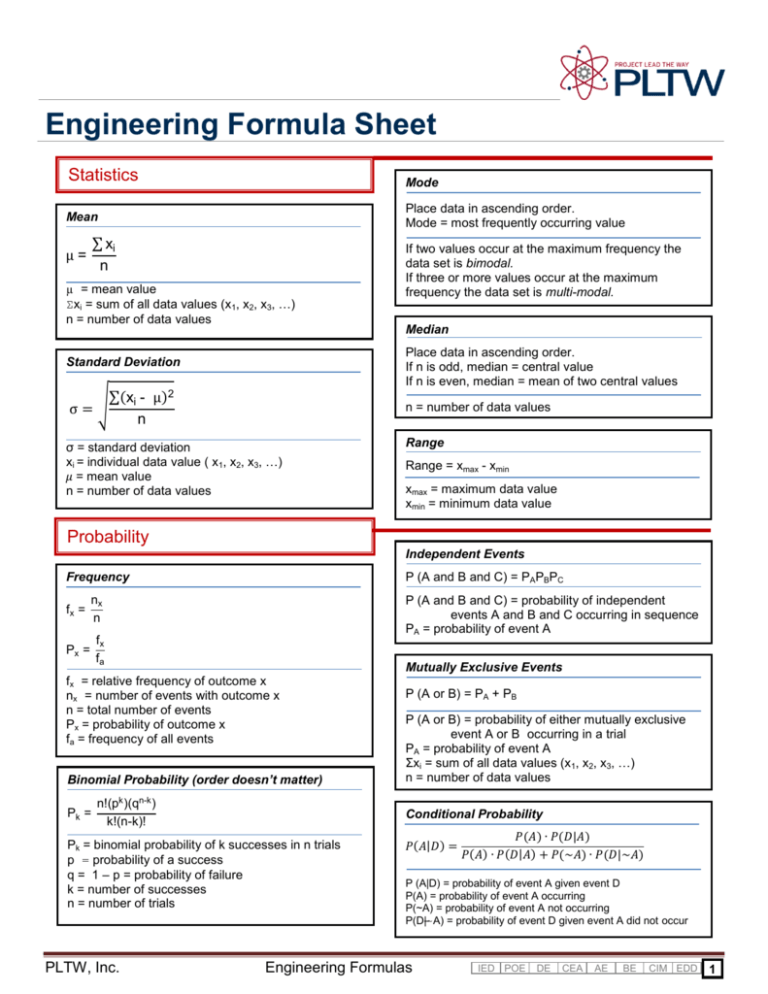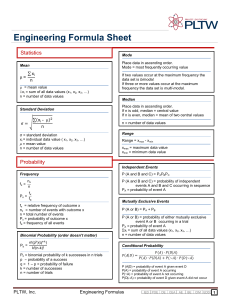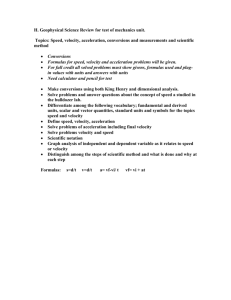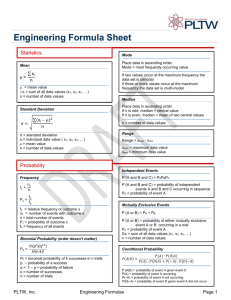Engineering Formula Sheet
advertisement

Engineering Formula Sheet Statistics Mode Mean Place data in ascending order. Mode = most frequently occurring value ∑x µ = mean value Σxi = sum of all data values (x1, x2, x3, … n = number of data values ∑(x Median Place data in ascending order. If n is odd, median = central value If n is even, median = mean of two central values Standard Deviation √ If two values occur at the maximum frequency the data set is bimodal. If three or more values occur at the maximum frequency the data set is multi-modal. ) n = number of data values σ = standard deviation xi = individual data value ( x1, x2, x3, … Range n = number of data values xmax = maximum data value xmin = minimum data value Range = xmax - xmin Probability Independent Events P (A and B and C) = PAPBPC Frequency P (A and B and C) = probability of independent events A and B and C occurring in sequence PA = probability of event A x x x x Mutually Exclusive Events fx = relative frequency of outcome x nx = number of events with outcome x n = total number of events Px = probability of outcome x fa = frequency of all events Binomial Probability (order doesn’t matter) P (A or B) = PA + PB P (A or B) = probability of either mutually exclusive event A or B occurring in a trial PA = probability of event A Σxi = sum of all data values (x1, x2, x3, … n = number of data values Conditional Probability Pk = binomial probability of k successes in n trials p = probability of a success q = 1 – p = probability of failure k = number of successes n = number of trials PLTW, Inc. ( | ) ( ) ( ) ( | ) ( | ) ( ) ( | ) P (A|D) = probability of event A given event D P(A) = probability of event A occurring P(~A) = probability of event A not occurring P(D|~A) = probability of event D given event A did not occur Engineering Formulas IED POE DE CEA AE BE CIM EDD 1 Plane Geometry Ellipse Rectangle 2b Circle Perimeter = 2a + 2b Area = ab 2a B Triangle Parallelogram h Area = bh a = b + c – 2bc·cos∠A 2 2 2 b = a + c – 2ac·cos∠B 2 2 2 c = a + b – 2ab·cos∠C C 2 c h 2 A b s Regular Polygons Right Triangle 2 a 2 b 2 Area = ½ bh f 2 c =a +b c a n = number of sides θ b a h Trapezoid Area = ½(a + b)h h h b h Solid Geometry Cube Sphere s 3 Volume = s 2 Surface Area = 6s r 3 s Volume r Surface Area = 4 s r 2 Rectangular Prism Cylinder r h Volume = wdh Surface Area = 2(wd + wh + dh) d w h 2 Volume = r h Surface Area = 2 r h+2 r 2 Right Circular Cone h Irregular Prism r √ h Volume = Ah A = area of base Pyramid h A = area of base PLTW, Inc. Constants 2 g = 9.8 m/s = 32.27 ft/s -11 3 2 G = 6.67 x 10 m /kg·s π = 3.14159 Engineering Formulas IED POE DE 2 CEA AE BE CIM EDD 2 Conversions Mass Force Area 2 1 acre = 4047 m 2 = 43,560 ft 2 = 0.00156 mi 1 kg = 2.205 lbm 1 slug = 32.2 lbm 1 ton = 2000 lbm 1N 1 kip Energy = 0.225 lbf = 1,000 lbf 1J = 0.239 cal -4 = 9.48 x 10 Btu = 0.7376 ft·lbf 1kW h = 3,6000,000 J Pressure Length 1m 1 km 1 in. 1 mi 1 yd 1 atm Volume = 3.28 ft = 0.621 mi = 2.54 cm = 5280 ft = 3 ft 1L 1mL = 0.264 gal 3 = 0.0353 ft = 33.8 fl oz 3 = 1 cm = 1 cc 1psi = 1.01325 bar = 33.9 ft H2O = 29.92 in. Hg = 760 mm Hg = 101,325 Pa = 14.7 psi = 2.31 ft of H2O Defined Units 1J 1N 1 Pa 1V 1W 1W 1 Hz 1F 1H Time Temperature Change 1K = 1 ºC = 1.8 ºF = 1.8 ºR 1d 1h 1 min 1 yr = 24 h = 60 min = 60 s = 365 d Power 1W = 3.412 Btu/h = 0.00134 hp = 14.34 cal/min = 0.7376 ft·lbf/s = 1 N·m = 1 kg·m / s2 = 1 N / m2 =1W/A =1J/s =1V/A = 1 s-1 = 1 A·s / V = 1 V·s / V SI Prefixes Numbers Less Than One Power of 10 Prefix Abbreviation 10-1 10-2 10-3 10-6 10-9 10-12 10-15 10-18 10-21 10-24 decicentimillimicronanopicofemtoattozeptoyocto- Equations d c m µ n p f a z y Numbers Greater Than One Power of 10 Prefix Abbreviation 101 102 103 106 109 1012 1015 1018 1021 1024 Temperature TK = TC + 273 Mass and Weight M = VDm TR = TF + 460 decahectokiloMegaGigaTeraPetaExaZettaYotta- da h k M G T P E Z Y Force F = ma F = force m = mass a = acceleration W = mg W = VDw V = volume Dm = mass density m = mass Dw = weight density g = acceleration due to gravity PLTW, Inc. Equations of Static Equilibrium TK = temperature in Kelvin TC = temperature in Celsius TR = temperature in Rankin TF = temperature in Fahrenheit Engineering Formulas ΣFx = 0 ΣFy = 0 ΣMP = 0 Fx = force in the x-direction Fy = force in the y-direction MP = moment about point P IED POE DE CEA AE BE CIM EDD 3 Equations (Continued) Energy: Work Electricity Ohm’s Law Fluid Mechanics V = IR P = IV W = work F = force d = distance RT (series) = R1 + R2+ ··· + Rn ’L ’ L (Guy-L Power P1V1 = P2V2 P = power E = energy W = work t = time τ = torque rpm = revolutions per minute Efficiency y Pout = useful power output Pin = total power input B y ’ L Kirchhoff’s Current Law Q = Av IT = I1 + I2 + ··· + In ∑ or A1v1 = A2v2 Kirchhoff’s Voltage Law VT = V1 + V2 + ··· + Vn ∑ or absolute pressure = gauge pressure + atmospheric pressure P = absolute pressure F = Force A = Area V = volume T = absolute temperature Q = flow rate v = flow velocity V = voltage VT = total voltage I = current IT = total current R = resistance RT = total resistance P = power Thermodynamics ′ Mechanics (where acceleration = 0) ∆T ∆ Energy: Potential (where acceleration = 0) U = potential energy m =mass g = acceleration due to gravity h = height L L A1v1 = A2v2 v = v0 + at Energy: Kinetic 2 d = d0 + v0t + ½at 2 2 v = v0 + 2a(d – d0) K = kinetic energy m = mass v = velocity Energy: Thermal Q = thermal energy m = mass c = specific heat ∆T = change in temperature PLTW, Inc. τ = dFsinθ s = speed v = velocity a = acceleration X = range t = time d = distance g = acceleration due to gravity d = distance θ = angle τ = torque F = force Engineering Formulas P = rate of heat transfer Q = thermal energy A = Area of thermal conductivity U = coefficient of heat conductivity (U-factor) ∆T = change in temperature R = resistance to heat flow ( R-value) k = thermal conductivity v = velocity Pnet = net power radiated = 5.6696 x 10 -8 e = emissivity constant T1, T2 = temperature at time 1, time 2 v = flow velocity POE 4 DE 4 Section Properties Moment of Inertia Rectangle Centroid h x x xx b Ixx = moment of inertia of a rectangular section about x-x axis ∑x ∑ and y̅ and y̅ Right Triangle Centroid x̅ and y̅ Semi-circle Centroid Complex Shapes Centroid x̅ x̅ x̅ ∑y y̅ ∑ x̅ x y̅ y xi = x distance to centroid of shape i yi = y distance to centroid of shape i Ai = Area of shape i x̅ x y̅ y Structural Analysis Material Properties Beam Formulas Reaction Stress (axial) B L Moment Deflection = stress F = axial force A = cross-sectional area L x B L Moment L x Reaction = strain L0 = original length δ = change in length Moment x (between loads) Deflection x ( L L Moment x E = modulus of elasticity = stress = strain A = cross-sectional area F = axial force δ = deformation PLTW, Inc. and Deformation: Axial δ L δ = deformation F = axial force L0 = original length A = cross-sectional area E = modulus of elasticity Engineering Formulas √ ) (at center) B L (at Point of Load) L Deflection (at ( (at center) B Reaction Modulus of Elasticity (at center) x Deflection L (at point of load) L Reaction Strain (axial) (at point of load) x ( )√ ( ) ( ) ) Truss Analysis 2J = M + R J = number of joints M =number of members R = number of reaction forces POE 5 AE 4 CEA 4 Simple Machines Inclined Plane Mechanical Advantage (MA) y ( L ) Wedge IMA = Ideal Mechanical Advantage AMA = Actual Mechanical Advantage DE = Effort Distance DR = Resistance Distance FE = Effort Force FR = Resistance Force L Lever Screw 1st Class IMA = Pitch = 2nd Class C = Circumference r = radius Pitch = distance between threads TPI = Threads Per Inch 3rd Class Compound Machines MATOTAL = (MA1) (MA2) (MA3) . . . Wheel and Axle Gears; Sprockets with Chains; and Pulleys with Belts Ratios Effort at Axle ( ) Compound Gears B GRTOTAL = ( ) ( Effort at Wheel Pulley Systems IMA = Total number of strands of a single string supporting the resistance IMA = PLTW, Inc. ) GR = Gear Ratio in = Angular Velocity - driver out = Angular Velocity - driven Nin = Number of Teeth - driver Nout = Number of Teeth - driven din = Diameter - driver dout = Diameter - driven in = Torque - driver out = Torque - driven Engineering Formulas POE 6 Structural Design Steel Beam Design: Shear Steel Beam Design: Moment Spread Footing Design qnet = qallowable - pfooting Vn = 0.6FyAw Mn = FyZx Va = allowable shear strength Vn = nominal shear strength Ωv = 1.5 = factor of safety for shear Fy = yield stress Aw = area of web Ma = allowable bending moment Mn = nominal moment strength Ωb = 1.67 = factor of safety for bending moment Fy = yield stress Zx = plastic section modulus about neutral axis Storm Water Runoff Storm Water Drainage Q = CfCiA 3 Q = peak storm water runoff rate (ft /s) Cf = runoff coefficient adjustment factor C = runoff coefficient i = rainfall intensity (in./h) A = drainage area (acres) Runoff Coefficient Adjustment Factor Return Period Cf 1, 2, 5, 10 1.0 25 1.1 50 1.2 100 1.25 Water Supply Hazen-Williams Formula L hf = head loss due to friction (ft of H2O) L = length of pipe (ft) Q = water flow rate (gpm) C = Hazen-Williams constant d = diameter of pipe (in.) Dynamic Head Rational Method Runoff Coefficients Categorized by Surface Forested 0.059—0.2 Asphalt 0.7—0.95 Brick 0.7—0.85 Concrete 0.8—0.95 Shingle roof 0.75—0.95 Lawns, well drained (sandy soil) Up to 2% slope 0.05—0.1 2% to 7% slope 0.10—0.15 Over 7% slope 0.15—0.2 Lawns, poor drainage (clay soil) Up to 2% slope 0.13—0.17 2% to 7% slope 0.18—0.22 Over 7% slope 0.25—0.35 Driveways, 0.75—0.85 walkways Categorized by Use Farmland 0.05—0.3 Pasture 0.05—0.3 Unimproved 0.1—0.3 Parks 0.1—0.25 Cemeteries 0.1—0.25 Railroad yard 0.2—0.40 Playgrounds 0.2—0.35 (except asphalt or Districts Business concrete) Neighborhood 0.5—0.7 City (downtown) 0.7—0.95 Residential Single-family 0.3—0.5 Multi-plexes, 0.4—0.6 detached Multi-plexes, 0.6—0.75 attached Suburban 0.25—0.4 Apartments, 0.5—0.7 condominiumsIndustrial Light 0.5—0.8 Heavy 0.6—0.9 qnet = net allowable soil bearing pressure qallowable = total allowable soil bearing pressure pfooting = soil bearing pressure due to footing weight tfooting = thickness of footing q = soil bearing pressure P = column load applied A = area of footing dynamic head = static head – head loss PLTW, Inc. Engineering Formulas CEA 5 PLTW, Inc. Engineering Formulas CEA 6 Equivalent Length of (Generic) Fittings Hazen-Williams Constants 555 Timer Design Equations T = 0.693 (RA + 2RB)C B y y B T = period f = frequency RA = resistance A RB = resistance B C = capacitance Boolean Algebra Boolean Theorems Commutative Law Consensus Theorems X• 0 = 0 X•Y = Y•X ̅ X•1 = X X+Y = Y+X ̅̅ ̅ X• X =X Associative Law ̅ X(YZ) = (XY)Z X+0=X X + (Y + Z) = (X + Y) + Z X+1=1 ̅ ̅ ̅̅̅̅ ̅ ̅ DeMorgan’s Theorems X+X=X Distributive Law ̅̅̅̅̅ ̅ ̅ ̅ X(Y+Z) = XY + XZ ̅̅̅̅̅̅̅ ̅ • ̅ ̿ ̅ (X+Y)(W+Z) = XW+XZ+YW+YZ Speeds and Feeds ( ) fm = ft·nt·N Plunge Rate = ½·fm N = spindle speed (rpm) CS = cutting speed (in./min) d = diameter (in.) fm = feed rate (in./min) ft = feed (in./tooth) nt = number of teeth PLTW, Inc. Engineering Formulas DE 5 CIM 4 Aerospace Equations Propulsion ( Orbital Mechanics ) Forces of Flight √ √ L L CL = coefficient of lift CD = coefficient of drag L = lift D = drag A = wing area density Re = Reynolds number v = velocity l = length of fluid travel = fluid viscosity F = force m = mass g = acceleration due to gravity M = moment d = moment arm (distance from datum perpendicular to F) FN = net thrust W = air mass flow vo = flight velocity vj = jet velocity I = total impulse Fave = average thrust force t = change in time (thrust duration) Fnet = net force Favg = average force Fg = force of gravity vf = final velocity a = acceleration t = change in time (thrust duration) NOTE: Fave and Favg are easily confused. Energy √ = eccentricity b = semi-minor axis a =semi-major axis T = orbital period a = semi-major axis gravitational parameter F = force of gravity between two bodies G = universal gravitation constant M =mass of central body m = mass of orbiting object r = distance between center of two objects Ber oulli’s L w ( ) ( ) PS = static pressure v = velocity y Atmosphere Parameters K = kinetic energy m =mass v = velocity U = gravitational potential energy G = universal gravitation constant M =mass of central body m = mass of orbiting object R = Distance center main body to center of orbiting object E = Total Energy of an orbit PLTW, Inc. Engineering Formulas [ ( ( ) ] ) T = temperature h = height p = pressure density AE 5






